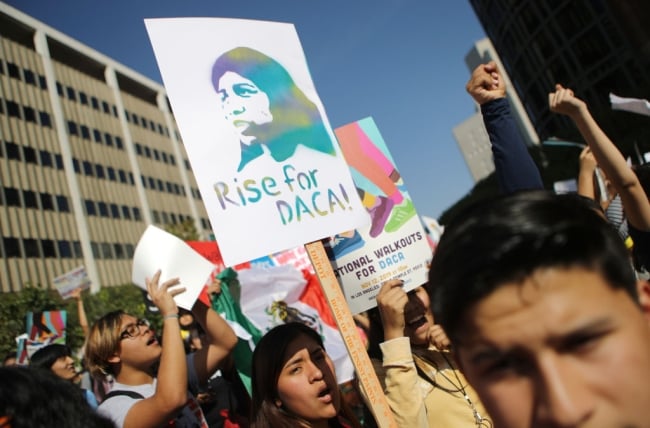You have /5 articles left.
Sign up for a free account or log in.

Undocumented students and other noncitizen community members in higher education face new challenges under the Trump administration.
Mario Tama/Staff/Getty Images North America
Since taking office in January, President Donald Trump has signed a slew of executive orders that have affected higher education institutions, students, staff and faculty members.
One of Trump’s top policy priorities has been limiting immigration and tightening restrictions for those within the U.S. who may be noncitizens, including immigrants, refugees or international students.
The Presidents’ Alliance on Higher Education and Immigration convened a webinar on March 5 to clarify the new executive orders and how they apply to higher education. Within the conversation, researchers provided some strategies and insights for practitioners on how to navigate the complex new landscape for student success.
State of play: In 2022, there were approximately 408,000 undocumented students enrolled in higher education in the U.S., around 119,000 of whom have DACA or are DACA eligible.
Around 5.6 million students from immigrant families attended U.S. college and universities in 2021, according to Migration Policy Institute analysis of U.S. Census Bureau data.
During his first two weeks, Trump signed executive orders that:
- Tighten visa vetting for all applicants, including F-1 and J-1 students.
- Direct the State Department and Homeland Security to ensure new and admitted immigrants do not advocate for, aid or support designated foreign terrorists or other threats to national security.
- Requires the attorney general and secretary of homeland security to review contracts, grants and agreements between the federal government and others who support or provide services to undocumented immigrants.
- Rescinded the sensitive locations policy, which protected schools, hospitals and churches from immigration enforcement actions.
“I think it’s important to keep in mind that ICE has not provided any specific directive about how and whether it will take enforcement action on campuses,” Anita Gupta, managing attorney of legal programs and initiatives at the Presidents’ Alliance, said during the webinar. “And the rescission of the protected areas or sensitive locations memo itself does not mean that previously protected areas like schools and campuses are now priorities for immigration enforcement.”
What Are Federally Funded Benefits?
The executive order “Protecting the American People Against Invasion” limits direct or indirect services provided to “removable or illegal aliens” funded by the federal government, which could apply to colleges that enroll undocumented students, operate legal aid clinics or offer in-state tuition to undocumented individuals, according to the American Council on Education.
Another order signed last month seeks to end “all taxpayer-funded benefits for illegal aliens,” according to the Associated Press. The federal government has yet to issue specific guidance, Diego Sanchez, director of policy and strategy, said during the Presidents’ Alliance webinar. “It really will depend on how the federal agencies define these benefits [and then] on how they identify which services to address,” meaning it is unclear what benefits or policies will be impacted.
Taking action: For campuses looking to protect their noncitizen students and employees, the alliance recommends:
- Establishing an immigration working group to lead efforts. This group should collect data on the campus community, identify existing supports, track policy development and share relevant guidance with impacted populations. Ideally, this working group would have a student representative (who receives an honorarium), Luz Bertadillo, director of campus engagement, said during the webinar.
- Reviewing and updating institutional policies and data protections to safeguard stakeholder information.
- Providing career guidance for undocumented students. Many noncitizen students lack avenues to participate in experiential learning, so institutions should consider some of the barriers to access and ways to circumvent these challenges.
- Supporting mental health and well-being of noncitizen students. “Campuses should create spaces where students feel seen and safe,” Bertadillo said. “For instance, hosting regular programming for students to move their body, to express themselves through the arts. Or group discussions that are facilitated by a mental health provider that knows how to work with these populations.”
- Offering basic needs support for undocumented students. Undocumented students don’t qualify for federal financial aid, and recent state policies may further reduce access to financial support. Basic needs resources and emergency grants can aid completion and graduation for students.
- Equipping stakeholders with their constitutional rights. Sharing Know Your Rights materials—such as those from the Civil Liberties Defense Center—with all campus community members, including students and employees, can help them understand how they are protected, regardless of immigration status.
- Designating nonpublic and public spaces on campus. The Fourth Amendment provides individuals the right to a reasonable expectation of privacy, so while campuses may not be protected as sensitive locations, designating areas on campus “determines the level of access federal immigration officers have and whether they need a warrant or consent to enter the space,” Gupta said. Nonpublic spaces can include those that require key-card access and those that are subject to certain hours or monitored, as well as faculty or administrative offices.
We bet your colleague would like this article, too. Send them this link to subscribe to our weekday newsletter on Student Success.








